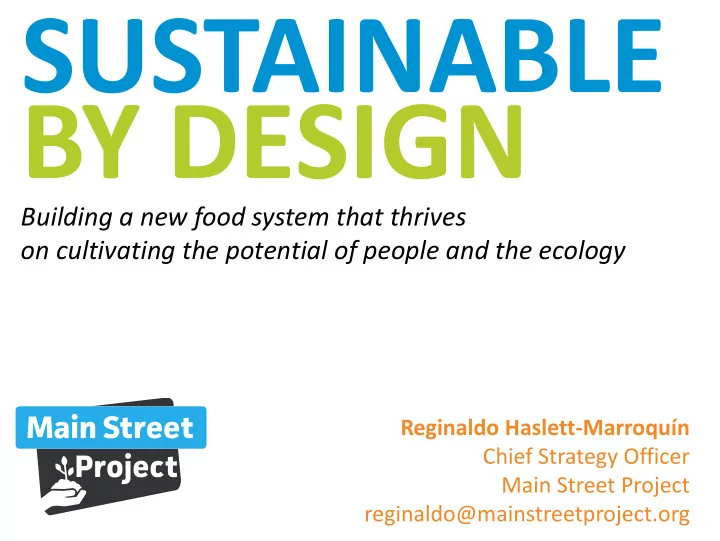

SUSTAINABLE BY DESIGN Building a new food system that thrives on cultivating the potential of people and the ecology Reginaldo Haslett-Marroquín Chief Strategy Officer Main Street Project reginaldo@mainstreetproject.org
Community Conditions • Landscape dominated by large factory farms and processors • Majority of the workers are of Hispanic/Latino/a background • Industrial food complex perpetuates inequity • Economic exploitation and poor working conditions* • Food insecurity • Increased diet-related health challenges * http://foodchainworkers.org/wp-content/uploads/2012/06/Hands-That-Feed-Us-Report.pdf
Poultry Centered Regenerative Agriculture Building a regenerative food system that has the power to revitalize rural communities, produce healthy food while caring for the land, and creating economic opportunities for low-income and immigrant farmers.
Poultry Centered Regenerative Agriculture Systems Mission: To build a system-level fully integrated, practical, inclusive, triple bottom-line strategy from where small farms can organize their operations to compete at a large-scale, nationally and internationally. Objectives: To transform existing farms • To engage new farmers • To involve immigrant farmers as agripreneurs to create • permanent large-scale system-level social justice To provide large-scale solutions to global issues generated • by degenerative agriculture systems
SUSTAINABLE BY DESIGN: PRINCIPLES Resilient Healthy Fair Sustainable Transparent
Community: Putting the Emphasis on the Most Important Asset. Would the system we were developing and testing work? We asked the community through neighborhood outreach and organizing For example: • Community gatherings • Over 1200 Latino/a families came together from different sectors in Red Wing, Northfield, Rochester, Faribault and Owatonna. • Show-of-hands voting and one-on-one conversations concluded that on average, 70% of the SE MN region’s Hispanic/Latina/o population: Wanted to farm. Found it to be the most spiritually rewarding occupation. Came from small farms, worked for farms, or lived in rural areas before coming to the US. Poultry was the one livestock option that everyone was familiar with. Found farming to be the most challenging and the least attainable goal in the US given the barriers. • 50+ meetings and presentations of our plan to NGO’s, community clubs, service organizations in the same communities Conclusion…… there was support for our system work to move forward.
Our Operating Strategy Small scale regenerative model Large scale impact
Why Free Range Poultry? (Meat and Eggs) • Benefits to the ecology • Short turnaround • Capacity to build resiliency fast (ecological, economic and social) • Cultural familiarity • Year-round production adaptability • Vertical integration potential • System change potential in a highly strategic industry sector • Easily adaptable for global impact
Ensuring the System is Accessible and Scalable for Beginner and Established Farmers One acre production unit equals 3 to 4 flocks per year 8 production units = 8-10 acre farm that can support a family 10 farms = economic cluster supporting community-based enterprises
End Result: A new system that delivers on the triple bottom- line, permanently for families, communities and regions.
Building a Community of Practice Around the New System Our Training Program Discovering, Developing, Launching and Growing the Farmers, The Farm, The System
Assets Based Development Celebrating Culture and Tradition Belonging, Appreciation and Pride
Classroom Training Enterprise Management and Self-Discovery Aspiring farmers develop their skills for small business management and planning through our Agripreneur Training Program.
Learning by Doing By bringing the classroom to the field, aspiring farmers further develop their natural skills and day-to-day animal welfare and business operations management.
Field Training Trainees build upon their own experience to learn more about our free-range poultry system and paddock management.
Incubator Program Restoring Hope That a Different Future is Possible Trainees gain experience in management of free-range poultry production as they raise their first flocks made available by Main Street Project. This reduces risk for the farmer, but most importantly, this process removes the mental and physical barriers that interfere with building the confidence and belief that a different system is attainable.
Where We Work
Our Current Focus SE Minnesota Building an Economic Cluster Current US Geographical Focus
Our Long-term Goal in Minnesota
Stages of Development STAGE INDICATORS (SOME) OF SUCCESS Proof of concept and • 100 Latin@ farmers trained, run production units prototyping • Producers undergo hands-on, classroom training (Already achieved) • Markets established, creating real-life training opportunities • Two new prototypes (training centers) • A large number of farmers from across the Midwest Farm level prototyping (in progress) trained with similar focus • Latin@ aspiring farmers partner up during training with SE MN small non-Latino/a landowners/farmers • Markets are expanded significantly • Value added is brought under ownership and control of Regional systems Latin@ farmers, workers and regional farmers networks deployment • 150 farms deployed, total gross farm production of $74 (under organization) million • Latino/a farmers are represented in the region (as a % of the population) in the ownership and control Institutionalization of • Schools start teaching the system the system (Structuring in process)
How We Fund Our Work Strong commitments from foundations. Individuals who provide: Volunteer hours • Annual cash and in-kind contributions (land, • equipment) Larger investments for property, plant and • equipment Practice-based partnerships that: Provide a strong network that independently fund • our projects on their sites A network of sites where social, economic and • ecological data can be collected from a diversity of conditions on the ground.
Top Challenges Access to Land Access to Financing Compatible with conditions of farmers • Training and Technical Assistance Lack of trained personnel • Lack of financial support to pay for trainings • Marketing and Communications Farm and system levels • Value added processing •
QUESTIONS?
Recommend
More recommend